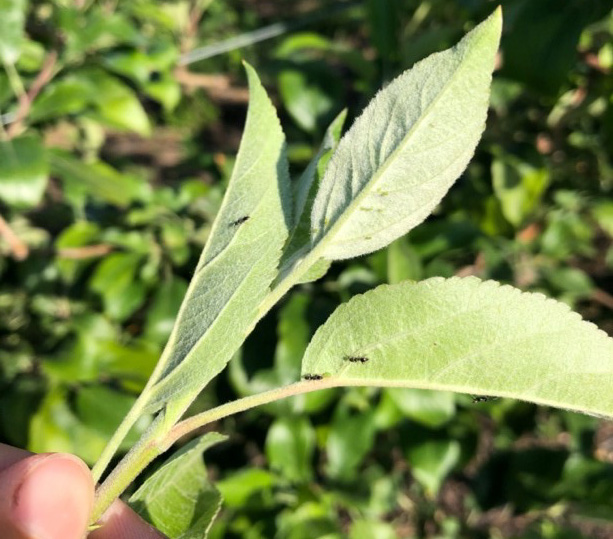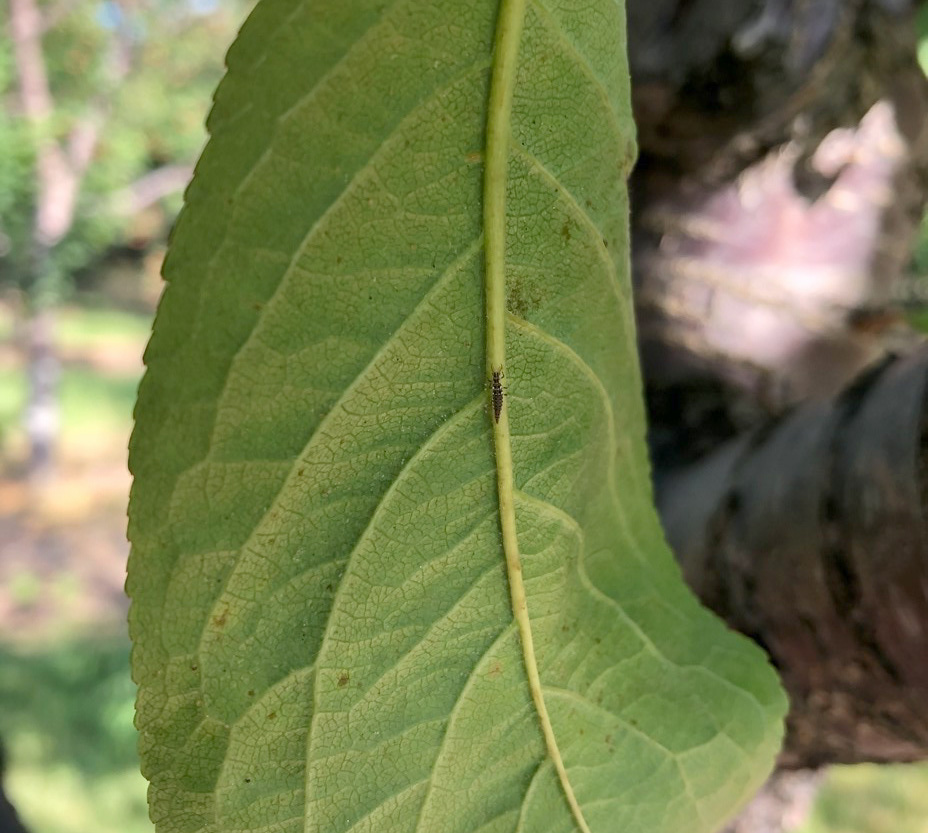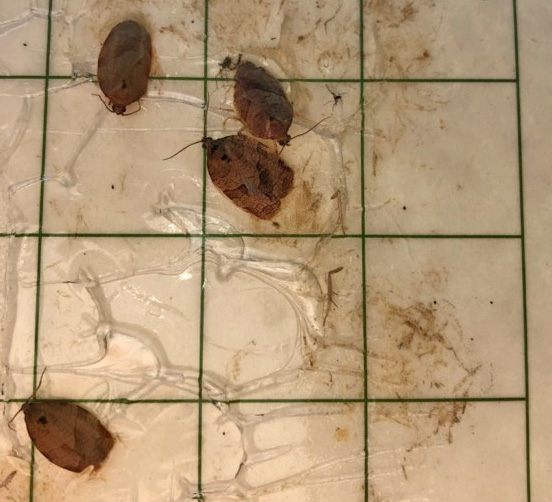Northwest Michigan fruit update – June 30, 2020
Hot and dry weather are in the forecast, which is helpful for disease control but growers will have to supplement water supply with irrigation.

Weather report
The weather is picture perfect for soaking up the sun for the Fourth of July weekend. Weather conditions will continue to be hot and dry, and the forecast will be warmer and dryer than normal. With the forecasted hot weather, orchards may be at risk for droughty conditions, if growers do not have irrigation. The predicted temperatures are expected to be in the high 80s and into the low 90s degree Fahrenheit. Michigan State University agricultural meteorologist Jeff Andresen also mentioned that there will be a high evaporative demand with daily PET rates from 0.2-0.25 inches. In addition to the dry conditions, there will be light winds, which may also impact PET rates. We have accumulated 1175 growing degree days (GDD) base 42 and 707 GDD base 50.
|
Growing degree days (GDD) through June 29, 2020 | |||||||
|---|---|---|---|---|---|---|---|
|
Year |
2020 |
2019 |
2018 |
2017 |
2016 |
2015 |
30 Yr. Avg. |
|
GDD42 |
1175 |
1030 |
1337 |
1310 |
1340 |
1213 |
1305.0 |
|
GDD50 |
707 |
578 |
837 |
750 |
794 |
732 |
769.2 |
Review Andresen’s weekly weather report below.
Crop report
Fruit is continuing to size. The overall crop for tart cherries is lighter than many growers expected. However, some growers have a decent crop, and other orchards in the same area have a light crop. The same situation is true in sweet cherries, where the crop is lighter than growers expected. We have seen some drop in the past two weeks, and the overall crop of sweets is relatively lighter than anticipated.
Growers have wrapped up thinning in apples as much of the fruit is too big for chemical thinning at this time. Most growers are pleased with their thinning this season, and we had had a lot of early drop in apples at the Northwest Michigan Horticulture Research Center, which helped the thinning process (but also was nerve-racking!).
Pest report
In apples, many growers called the end to primary apple scab season with their final primary fungicide that was applied ahead of possible rain that was supposed to arrive late last week. Some areas received light rains, but it was a drier than predicted. Apple scab symptoms from infection periods last week should show up this week. The most significant infection in the recent past was early last week, which also aligned with the tail end of primary. Powdery mildew is also more noticeable as white mycelia are growing on the leaves, and while fungicides may not stop the spread of this fungus, they can help to prevent the development of other summer fungal diseases. Continue to monitor for disease symptoms, especially if you are planning to loosen up fungicide programs, to ensure that a pathogen doesn’t slip too far off the radar.
Recent weather has not been favorable for spreading cherry leaf spot conidia, but new lesions could be visible this week following the long wetting period that begin on June 22. Like in apples, powdery mildew is also showing up on both sweet and tart cherry. Currently, conditions look dry for the coming week, which will continue to be unfavorable for perpetuating this disease. Forecasts can change quickly, so keep an eye on the weather to ensure fungicide coverage is not stretched too far and that orchards are covered ahead of possible rain.
While dry weather is not as conducive for American brown rot development, orchards, especially those with large dense canopies and overgrown ground cover, have been humid and uncomfortable this week. Cooler temperatures in the 70s are good conditions for brown rot. While daytime temperatures are predicted to be 80-plus F, early mornings and overnight temperatures will be in the more optimal range for this fungus.
Sweet cherries colored up over the weekend, and bird damage is not difficult to spot. Compromised fruit from birds, insects, canker, etc. are a good host for brown rot. Again, while rain is not predicted for an extended period, higher relative humidity can support brown rot growth. With the potential for high inoculum leftover from last season and damaged fruit already in orchards, do not get stretched too far on coverage for brown rot this season.
Codling moth flight is ongoing and trap numbers are lower with one to 10 moths per trap; these catches are down from last week’s 20-40 moths per trap. Trap catches were much higher last week than catches that we usually observe at the station. As an exercise, we are tracking growing degree days from last week’s observations on June 22 to ensure we are well-prepared for a good flush of codling moth egglaying and to estimate when those larvae will be hatching.
Currently, we are at 166 GDD base 50 from June 22, indicating egglaying is underway, and we will reach 250 GDD base 50 on Friday or Saturday, July 3-4, this week. This timing aligns with the estimated peak egg hatch (about 550 GDD base 50 since biofix, June 1) for first generation codling moth. Hence, for a June 1 biofix, codling moth sprays timed for late this week would be well-timed for peak egg hatch and covering the eggs from this flush of codling moth activity that occurred last week. Good control of the first generation of this pest can have a significant impact to reduce pressure from the second generation.
Aphid populations are growing on terminal ends, and they can be found on both mature and young apple blocks at the station (Photo 2). Additionally, immature leafhoppers are also now present. Ants were on the scene, tending the aphids and guarding them from predators. Proactive management of these sucking insects is needed particularly when using contact insecticides as feeding causes leaves to curl and the curled leaves prevent spray material from contacting the pests hidden within.

European red mites and spider mite populations are building relatively quickly in hot temperatures. Reports from commercial orchards suggest numbers are still low in areas where mites have been targeted in management programs. European red mites can turn over a generation in a as little as 10 days at average daily temperatures of 75 F. We have observed leaf stippling where twospotted spider mites are present, and bronzing is becoming noticeable in some apple blocks at the station where European red mite populations are especially high. A green lacewing larva, a known natural enemy, was found feeding on mites on cherry leaves at the station (Photo 3).

Obliquebanded leafroller are flying, and all our traps at the station were catching single digits of these moths (Photo 4). The moths were still alive, indicating = flight is just beginning at the station. Sustained catch is needed to set biofix. If we set biofix for yesterday, June 29, we will accumulate about 300 GDD base 42 by Monday, July 6. Egg hatch is estimated to begin about 400-450 GDD base 42 after biofix. Some areas that are ahead of the station set biofix last week on June 22, and egg hatch will begin in those areas toward the end of this week.

We observed the first San Jose scale crawlers at the station yesterday. We have a few hot spot locations in sweet cherry and apples at the station where we have been monitoring for crawler emergence. Orchards with high pressure and ongoing challenges with this pest should begin management programs this week. However, additional management could be needed to target peak crawler activity. Please refer to “San Jose scale crawler emergence beginning in Michigan tree fruit” from MSU Extension for additional information on management.
Rose chafers are still active, but activity should be winding down. The beetles have been active for over two weeks and adults typically live for about three weeks. We have observed hot spots of rose chafers at the station, and some damage on apple fruit is evident. After feeding and mating, the adults will lay eggs in the soil where the immature stages will remain until next year.
Greater peach tree borer flight has begun, and lesser peach tree borers are also still flying. We caution growers that the traditional borer spray, Lorsban, has a 21-day preharvest interval in cherry and 14-day preharvest interval in peach, plum and nectarine.
According to the beta model for spotted wing Drosophila (SWD), sweet cherries in much of the region are susceptible to oviposition; tart cherries are just a few days behind (Table 1). By Friday, July 3, the model is predicting both sweet and tart cherries will be susceptible to SWD infestation. However, depending on local some areas, may be a few days ahead or behind these indicators. SWD catches have been consistent for two weeks with a good percentage of traps in the area catching the flies. Hence, growers should begin programs to prevent oviposition into susceptible fruit. Hot conditions this week will help to slow daytime SWD activity, but evenings and early mornings will be cooler conditions for the flies to be active. We still have much to learn about the behavior of this insect, and a proactive approach to protect fruit when they are susceptible will minimize the risk of infested fruit at harvest.
Finally, this season there are two 24 C Special Local Needs labels to help growers manage SWD close to harvest. These labels are for a three-day preharvest interval for Mustang Maxx in tart cherry and sweet cherry. Please note that a requirement of making applications under this label is to have the label in the possession of the user at the time of the application. Please review these labels for restrictions prior to making applications under them.
|
Traps (0=flies not present, 1=flies present) |
GDD 39.2 F from full bloom |
SWD risk |
|---|---|---|
|
0 |
GDD>1170 |
low |
|
1 |
954>GDD |
low |
|
1 |
954<GDD<1170 |
medium |
|
1 |
GDD>1170 |
high |
|
Table 1. Updated SWD Model for June 29, 2020 | ||||
|---|---|---|---|---|
| Site | Crop | Bloom | Current DD Base 39.2 F From bloom to June 29 | Forecast DD Base 39.2 F From bloom to July 3 |
| SWMREC | Sweet cherry | 1-May-20 | 1484 | 1640 |
| Commerce TWP | Sweet cherry | 4-May-20 | 1306 | 1456 |
| Romeo | Sweet cherry | 4-May-20 | 1302 | 1445 |
| Sparta | Sweet cherry | 7-May-20 | 1264 | 1418 |
| Benzonia | Sweet cherry | 20-May-20 | 1006 | 1147 |
| NWMHRC | Sweet cherry | 22-May-20 | 995 | 1138 |
| Elk Rapids | Sweet cherry | 22-May-20 | 949 | 1042 |
| Old Mission | Sweet cherry | 22-May-20 | 954 | 1092 |
| Williamsburg | Sweet cherry | 22-May-20 | 969 | 1114 |
| East Leland | Sweet cherry | 23-May-20 | 895 | 1032 |
| Commerce TWP | Tart cherry | 10-May-20 | 1271 | 1421 |
| Romeo | Tart cherry | 10-May-20 | 1270 | 1413 |
| SWMREC | Tart cherry | 12-May-20 | 1391 | 1546 |
| Hart | Tart cherry | 17-May-20 | 1043 | 1186 |
| Benzonia | Tart cherry | 24-May-20 | 908 | 1050 |
| East Leland | Tart cherry | 25-May-20 | 849 | 986 |
| Eastport | Tart cherry | 25-May-20 | 870 | 1014 |
| Old Mission | Tart cherry | 25-May-20 | 883 | 1021 |
| NWMHRC | Tart cherry | 26-May-20 | 890 | 1034 |



 Print
Print Email
Email

